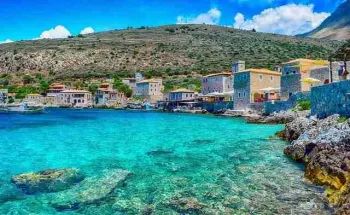The Peloponnese
Explore the Peloponnese: A First-Time Visitor’s Guide
The Peloponnese, located in southern Greece, offers a rich blend of history, natural beauty, and cultural depth. For those looking to explore the Peloponnese for the first time, this region promises a journey filled with ancient landmarks, charming towns, and unforgettable landscapes. Whether you're drawn by mythology, architecture, or coastal serenity, the Peloponnese invites you to discover its many treasures.
Ancient Olympia: Where the Olympic Spirit Was Born
Begin your journey at Ancient Olympia, the birthplace of the Olympic Games. This historic site transports you to a time when athletes competed in honour of the gods. Wander through the remains of the gymnasium and stadium, and admire the Temple of Zeus, once home to one of the Seven Wonders of the Ancient World.
The archaeological site is peaceful and well-preserved, offering a chance to reflect on the origins of global sporting traditions. A visit here is especially rewarding for those interested in ancient history and Greek mythology.
Mycenae: Legends and Legacy
Next, head to Mycenae, a city steeped in myth and legend. Enter through the Lion Gate, the imposing entrance to this once-powerful centre of the Mycenaean civilisation. Explore the ruins of the royal palace and the beehive-shaped tombs, which reveal the architectural ingenuity of the era.
The nearby Archaeological Museum displays artefacts that help bring the stories of Agamemnon and Clytemnestra to life. Mycenae offers a compelling glimpse into Greece’s Bronze Age and is a must-see for history enthusiasts.
Nafplio: Coastal Charm and Venetian Elegance
Continue your journey to Nafplio, a picturesque town by the sea. Its pastel-coloured buildings, cobbled streets, and lively harbour create a welcoming atmosphere. Stroll through the old town, where boutique shops and cafés invite you to pause and enjoy local flavours.
Climb the 999 steps to Palamidi Fortress for sweeping views of the town and the Argolic Gulf. Alternatively, take a boat ride to Bourtzi Castle, a small fortress on an island that seems to float on the water. Nafplio’s blend of history and romance makes it ideal for a relaxed day of exploration.
Epidaurus: Acoustics and Ancient Drama
Not far from Nafplio lies Epidaurus, home to one of the best-preserved ancient theatres in Greece. Renowned for its exceptional acoustics, the theatre allows even the softest sounds to reach the furthest seats. Surrounded by greenery, the site offers a tranquil setting for reflection and appreciation.
During the summer, the Epidaurus Festival brings classical plays and concerts to the venue, creating a magical experience under the stars. Visiting Epidaurus is a highlight for anyone interested in architecture, performance, or ancient culture.
Sparta and Mystras: Echoes of Strength and Spirituality
To explore the Peloponnese further, travel to Sparta, a city known for its legendary warriors. Although the ancient ruins are modest, the Archaeological Museum provides valuable insight into Spartan society and traditions. A statue of King Leonidas commemorates the bravery of the 300 warriors who fought at Thermopylae.
Nearby, the Byzantine city of Mystras offers a different perspective. Its hillside location features churches, palaces, and frescoes that reflect medieval life in Greece. Walking through Mystras reveals a quieter, spiritual side of the region’s history.
Mani Peninsula: Tower Houses and Coastal Beauty
The Mani Peninsula presents a dramatic contrast with its rugged terrain and stone tower villages. Towns like Areopoli and Vathia showcase unique architecture and a slower pace of life. Narrow alleys and traditional homes invite exploration and offer insight into local customs.
Along the coast, pristine beaches and clear waters provide a refreshing escape. The combination of mountain views and seaside tranquillity makes Mani ideal for those seeking both cultural depth and natural beauty.
Pylos: History by the Sea
On the southwestern coast, Pylos welcomes visitors with its calm beaches and historical significance. The Bay of Navarino, a natural harbour, was the site of a pivotal naval battle in 1827 during Greece’s fight for independence.
Explore Neokastro, a Venetian fortress overlooking the bay, and hike to Palaiokastro for panoramic views. Pylos offers a peaceful retreat where history and nature coexist, making it a rewarding stop for those who want to explore the Peloponnese at a relaxed pace.
Tips for First-Time Visitors
To make the most of your journey, consider the following:
- Best Time to Visit: Spring and autumn offer mild weather and fewer crowds. Summer is popular but can be hot, especially inland.
- Transport: Renting a car is recommended, as public transport is limited in rural areas. Roads are generally well-maintained and signposted.
- Accommodation: Options range from boutique hotels to guesthouses. Booking in advance is advisable during peak seasons.
- Local Etiquette: Dress modestly when visiting religious sites and greet locals with a friendly “Kalimera” (good morning).
- Food and Drink: Enjoy regional dishes such as grilled meats, fresh seafood, and local cheeses. Many tavernas serve homemade wine and olive oil.
Final Thoughts on Exploring the Peloponnese
To explore the Peloponnese is to step into a region where history, nature, and culture intertwine. From ancient Olympia to the tower villages of Mani, each destination offers a unique perspective on Greece’s past and present.
Whether you’re drawn to archaeological sites, coastal towns, or mountain landscapes, the Peloponnese provides a journey filled with discovery and connection. Its welcoming communities, scenic routes, and rich traditions make it an ideal destination for curious travellers.
As you explore the Peloponnese, you’ll find that every stop adds depth to your experience. The region’s timeless charm and diverse offerings ensure that your first visit will be both memorable and inspiring.

